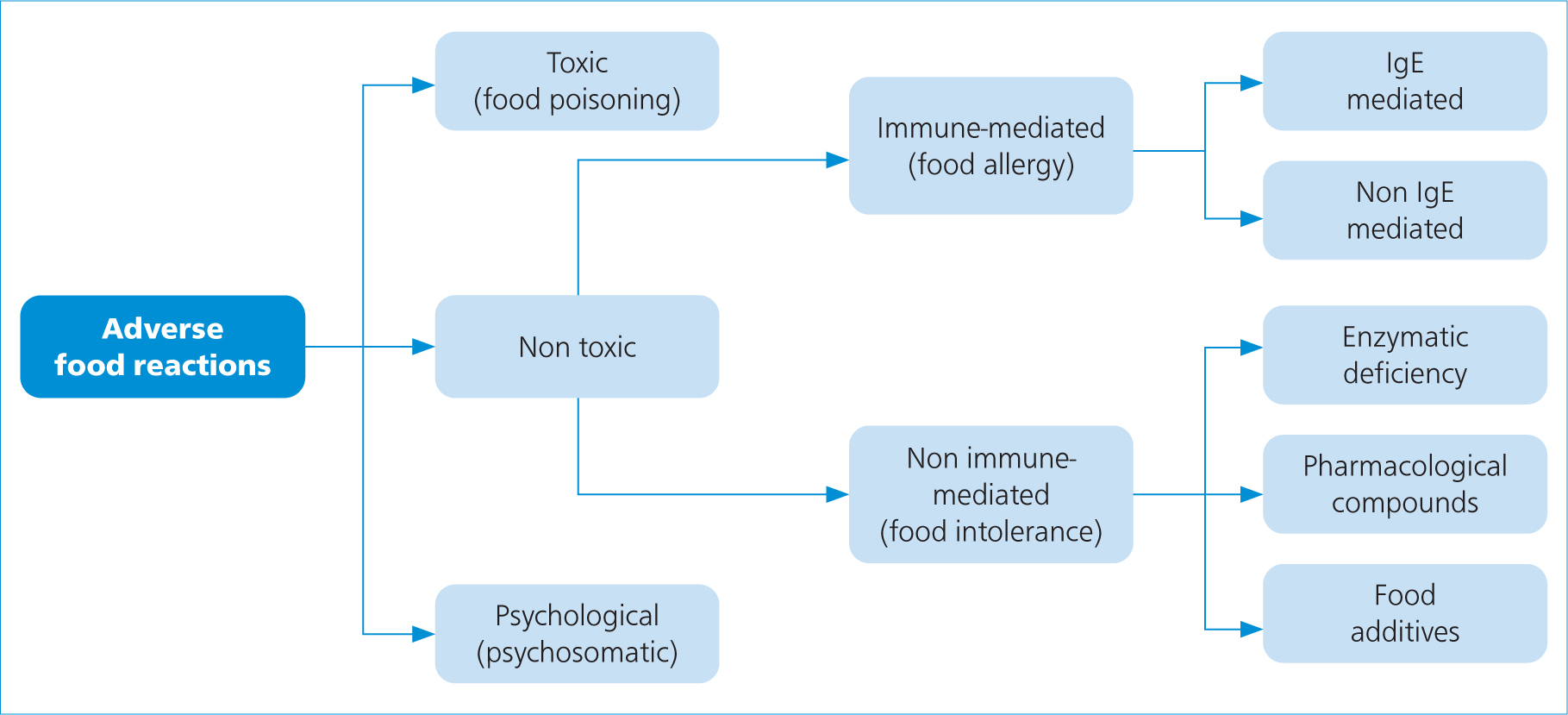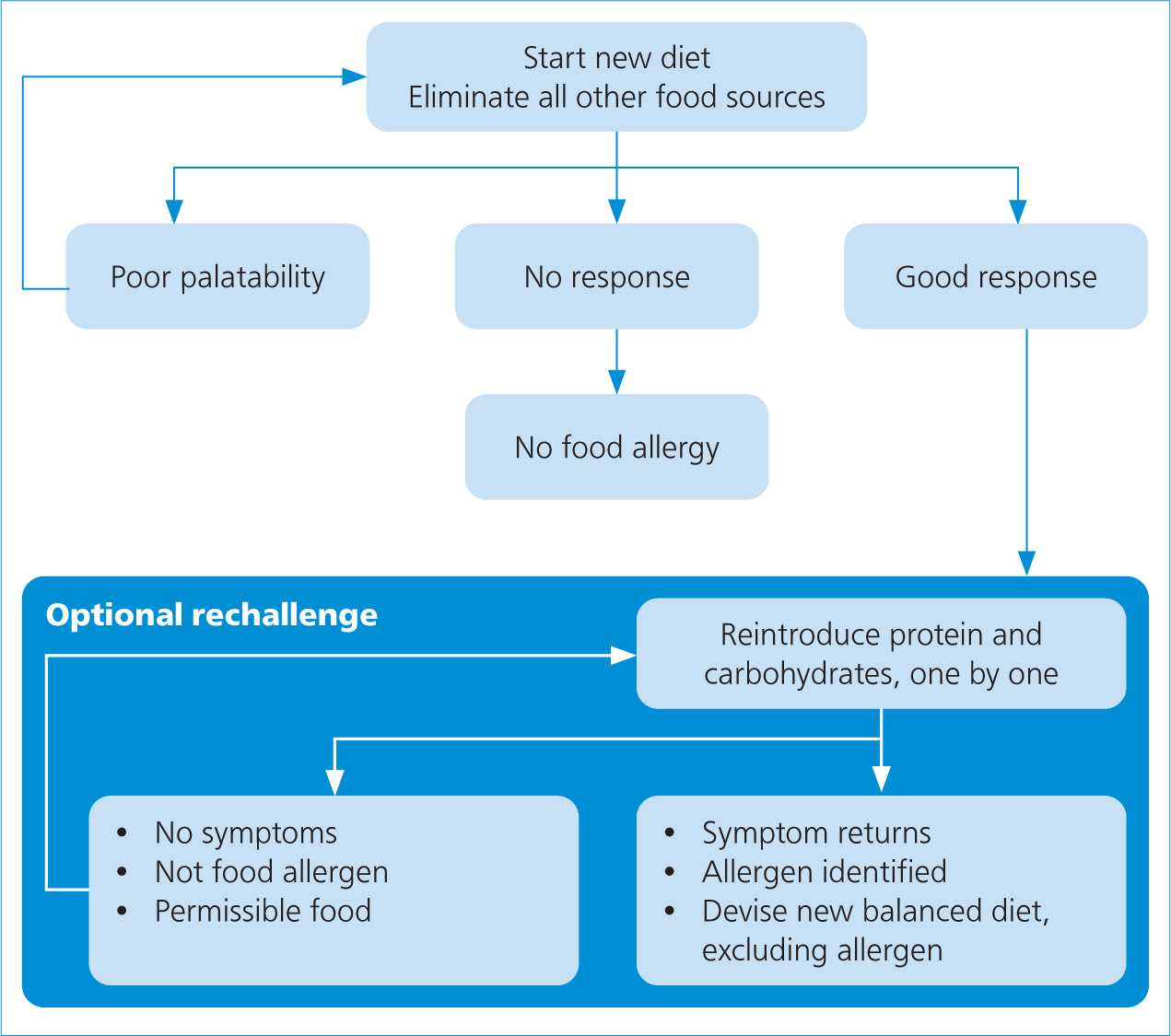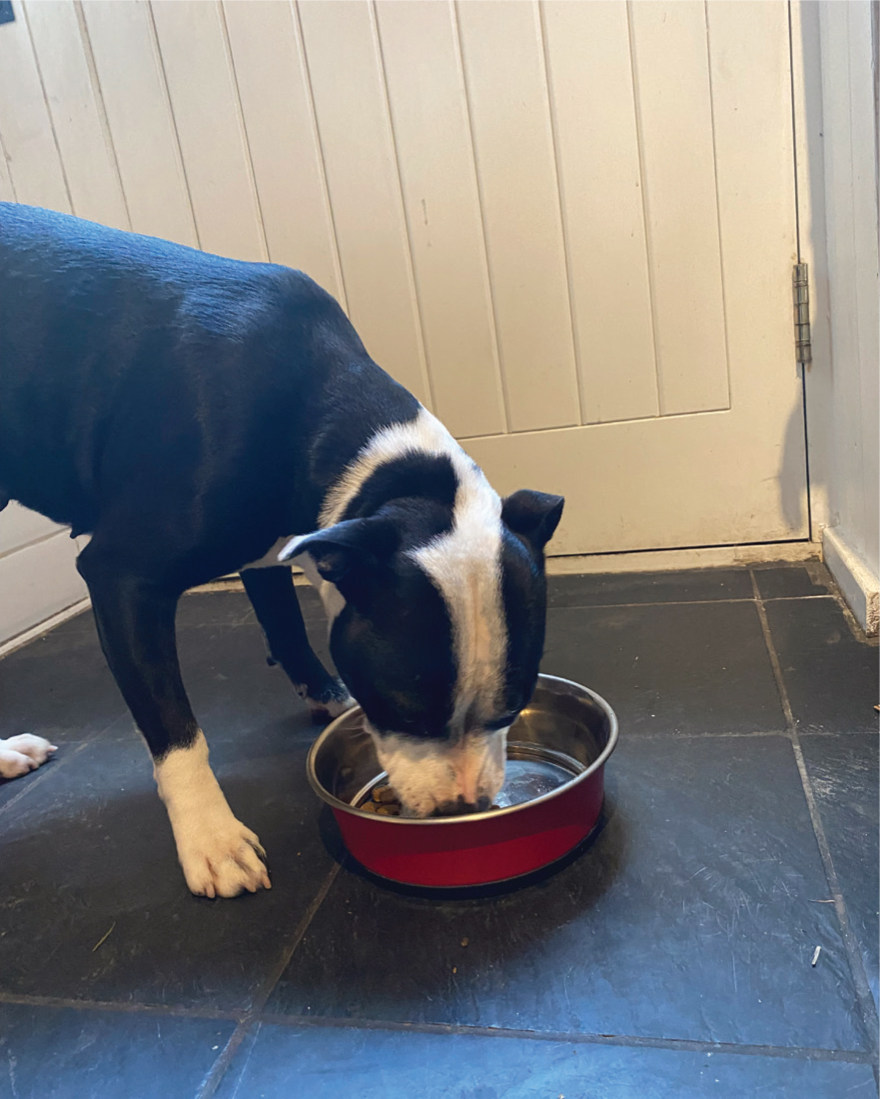The terms food allergy and food hypersensitivity should be reserved for those adverse reactions to food that have immunologic basis. Food intolerance refers to cutaneous adverse food reactions (CAFR) as a result of non-immunologic mechanisms, although distinguishing between the two can be very difficult, with diagnosis and treatment pathways being similar (Bethlehem et al, 2012; Mueller et al, 2016). Gaschen and Merchant (2011) suggested in a review of studies that only 1–6% of all dermatoses seen in practice relate to adverse food reactions and that food allergies constitute 10–20% of allergic responses in dogs and cats (Figure 1). A full dermatological work up is required before a nutritional factor can be entirely confirmed. It can be commonplace, however, for owners to self-diagnose their pet's food allergy or intolerance, even before seeing the veterinary surgeon (Tiffany et al, 2019). There are many diets available that are gluten free, grain free, hypoallergenic and/or natural (Table 1); and when the pet improves on these diets the owners assume that their pet had an allergy to one of the ingredients, in many cases it is purely a coincidence (Tiffany et al, 2019). These diets can appeal to many owners that are looking for a way to help their pet.

Table 1. Nutritional terms and definitions
| Nutritional terms | Definition |
|---|---|
| Gluten free | Diet does not contain any gluten, which is a mixture of proteins found in wheat, as well as barley, rye, and oats |
| Grain free | Diet does not contain any cereals, this includes wheat, rye, barley, oats, maize, sorghum, millet, triticale or rice. Carbohydrate source can be from sweet potatoes, potatoes, legumes (peas) |
| Hypoallergenic | Meaning ‘below average’ or ‘slightly’ allergenic — meaning that something causes fewer allergic reactions. Not a protected term with no quantitative definitions |
| Natural | The European Petfood Industry Federation (FEDIAF) states that natural pet foods should only contain components to which nothing has been added and have undergone only processing that maintains their natural composition |
The skin is the largest organ of the body and has a heavy demand on bodily nutrient supply. When factors become sub optimal it is usually the skin that becomes the first organ to demonstrate deterioration. Anecdotally owners can detect signs of deterioration, loss of coat sheen, coat shedding, and the coat can become greasy and scurf at the skin surface can be evident, but in many cases the signs of deterioration occur at such a slow rate that owners do not notice. It is not until the issue is resolved, or the animal is placed on a different diet that the animal's coat returns to ‘healthy’ and the owner notices a difference.
Food intolerance is not so clear cut; although not life threatening, it can and often does, make the sufferer feel extremely unwell and can have a major impact on life. In some intolerances animals can lack the enzymes needed to break foods down; for example, lactose intolerance where the enzyme lactase is not produced in large enough quantities to break down the lactose (milk sugars) in milk. Food intolerance reactions do not involve IgE, and the mechanisms are unclear; however, reactions are more likely to be delayed with the reaction occurring several hours and sometimes up to several days after eating the offending food (Turnball et al, 2015). The symptoms caused by these reactions are numerous, but have been associated with gut symptoms such as bloating, diarrhoea, constipation, and inflammatory bowel disease/disorder (IBD), and skin problems such as eczema. Specific food additives that are known to cause problems include onions and propylene glycol, which can cause haematological abnormalities in cats. Lactose intolerance is a relatively common metabolic adverse reaction in dogs and cats. Diarrhoea can develop when given cow's or even goat's milk, because of the lactose content being higher than that of a bitch's or queen's milk. Gluten sensitive enteropathy has been well documented in Irish Setters (Garden et al, 2000).
Inflammatory bowel disease and food intolerances
The role of food allergies in canine and feline IBD is unknown. In IBD, the immune system responds incorrectly to environmental triggers, which can include food, that causes inflammation of the gastrointestinal tract. There also appears to be a genetic component — an animal with a family history of IBD is more likely to develop this inappropriate immune response. One UK referral centre examining breed predisposition for chronic enteropathies reported increased odds ratios for developing disease in Weimaraners, Rottweilers, German Shepherds, Border Collies and Boxers (Kathrani et al, 2011).
It is thought that hypersensitivity to food is involved in the pathogenesis of this syndrome. The role of elimination food trials often alleviate the signs of IBD, which does seem to imply that food allergies or food intolerances could play a role in this syndrome.
Elimination diets
When designing or recommending an elimination diet certain characteristics do need to be taken into consideration. Review the diet history sheets and diaries to give you an indication of what the animal has been exposed to in the past. A limited number of protein sources are required, along with the protein being of a novel source. Excessive levels of protein should be avoided; the protein present needs to be of a digestibility greater than 87%. Digestibility levels should be available from the food manufacturers. Hydrolysed protein can be used, as digestibility is high. Digestibility is an important factor as free amino acids and small peptides make poor antigens. The diet needs to be free of additives and excessive levels of vasoactive amines, while still being nutritionally adequate for the animal's life stage and body score.
Hydrolysed diets are advantageous as they remove the absolute necessity of finding the primary causal agent of the food allergen. Hydrolysed diets work by taking a protein and reducing it in size through hydrolysis. When the hydrolysed protein is then ingested, the body no longer recognises the protein as an antigen, and the allergic immune response is not initiated. The use of carbohydrates in the diet also needs to be limited, as in many elimination diets the use of a novel carbohydrate source is also utilised. Many carbohydrates sources used include, rice, potato and tapioca. Some carbohydrate sources will also contain proteins, so using a novel source might be prudent.
Feeding an elimination food (dermatological and gastrointestinal disease)
The main diagnosis method for nutritional adverse food reactions is dietary elimination trials with either a commercial product or a homemade diet. It must be noted that homemade diets are likely to be nutritionally inadequate for maintenance requirements. Most homemade diets lack a source of calcium, essential fatty acids, vitamins and other micronutrients (Streiff et al, 2002; Lauten et al, 2001; Hutchonson et al, 2012; Larsen et al, 2012; Stockman et al, 2013; Hall et al, 2020). If the owner is insistent on the use of a homemade diet, guidance on constructing a balanced diet is required from the veterinary practice.
To make a diagnosis of nutritional adverse food reactions only the elimination food can be used. The trial needs to be performed for several weeks to months, and full dedication from the owner is required. Olivry et al (2015) described complete remission of dermatologic signs of food allergies in 90% of dogs when the elimination trial was a minimum of 8 weeks long. Tiffany et al (2019), found that with gastrointestinal signs, the duration of amelioration reported by owners was much more rapid, with recovery times varying from <2 weeks at minimum, and most clinical signs ameliorated by 4 weeks. This was attributed to the high cell turnover rate. Newly generated intestinal epithelial cells migrate from the base of the crypts toward the villus tip region, where loss of senescent epithelial cells occurs. Complete renewal of the villus epithelium takes 2–6 days in most mammals (Moriello et al, 2010; Williams et al, 2015).
Elimination trials can prove to be extremely useful when diagnosing the causal nutritional agent in both dermatological and gastrointestinal disease (Figure 2). A strict elimination trial protocol does need to be adhered to, and the owner and anyone in contact with the animal needs to be aware of this. No foodstuffs, other than the elimination food, should be ingested over this period. This includes treats, flavoured vitamins, chewable/palatable medications; fatty acids supplements and chew toys. Advice must be clearly conveyed to the owner when discussing the use of an elimination food trial. The patient is fed the controlled diet for 4 to 12 weeks for dermatological disease. A shorter period of 2 to 4 weeks is usually satisfactory in gastrointestinal disease. The degree of clinical improvement during the elimination trial will be 100%, only if food sensitivity is the sole causal agent. These trials are often difficult to interpret in dermatological disease. This is a result of concurrent allergic skin disease. These patients may only partially respond to an elimination trial. Confirmation of a diagnosis can be made to an adverse food reaction when the clinical signs reoccur within 10–14 days after the animal is challenged with its original diet. Always give the client written instructions describing the requirements of the elimination trial and feeding quantities. Details on how to contact an advising veterinary nurse can prove useful if the owners have any questions during the trial or require support. Giving good clear instructions, both verbal and written, can help in aiding with compliance.

Dietary contaminations
In Europe allergies to house-dust and storage mites play an important role and are more significant than pollens (Fernández-Caldas, 2013). Positive reactions to mites from the Acarus genus are seen in between 45–95% of atopic dogs, to mites in the Tyrophagus genus in 60–89% and to the house dust mite Dermatophagoides farinae in 70–90%, depending on the literature source (Nuttall et al, 2006). Arlian et al (2003) showed that 94% of the dog with atopic dermatitis had serum IgE against proteins originating from storage mite species. Brazis et al (2008) demonstrated that 90% of dermatological diets studied had storage mites evident after 5 weeks of opening the packaging.
Gill et al (2011) investigated how to store dry commercial foods. Mites were identified in six of 10 paper bag, three of 10 plastic bag, one of 10 plastic box and nine of 10 house dust samples after 90 days. This shows the importance of storage of the diet, cleaning of storage containers and only using volumes of food that would feed the pet for a month (Figure 3). Olivry and Mueller (2019) critically appraised the topic (CAT) of commercial diet contamination, finding 10 studies, with five reporting results of laboratory experiments, and five from field studies. Recommendations were made based on this CAT that commercial dry pet foods should be kept indoors and sealed to decrease the risk of contamination with storage mites. When performing dietary restriction (elimination) and provocation trials for the diagnosis of food allergies in dogs, it seems preferable to choose newly-purchased bags — of both original and testing diets — to reduce the probability of their contamination with storage mites, especially Tyrophagus putrescentiae. There is a potential that storage mite contamination might lead to an erroneous diagnosis of food allergy in house dust mite-sensitised dogs (Olivry and Mueller, 2019).

Prolonged elimination can build tolerance
Weeks or months of elimination of the reactive food may well lead to reintroduction of the food without reaction. This is known as tolerance, and its maintenance depends on establishing the threshold of both frequency and quantity for that person and/or animal — in other words, eating the food occasionally may be tolerated, but reintroducing it in large quantities or on a very regular basis (e.g. every day) might lead to symptoms recurring. This is purely individual so working this out and not restricting the diet more than is necessary is a major consideration.
Conclusion
Food intolerances can cause a variety of clinical signs, from skin issues to gastrointestinal signs. A thorough diagnostic work-up by the veterinary surgeon is required, part of this can include a food elimination trial. These trials can prove to be useful, but interpretation of them can be difficult. Exceptionally good client guidance is needed in diet trials to assure compliance. Veterinary nurses should take a pivotal role in aiding clients with these food trials, in both guidance and support throughout.
KEY POINTS
- Good client compliance is needed for an elimination diet trial to be completed.
- In order to gain good compliance owners need to be fully aware of the importance of abiding by strict feeding guidelines.
- Good hygiene for fomites associated with feeding is required — this includes food storage bins and feeding bowls.
- Recommendation to only buying bags of food that will last a month (30 days) can help in the prevention of contamination with mites.


